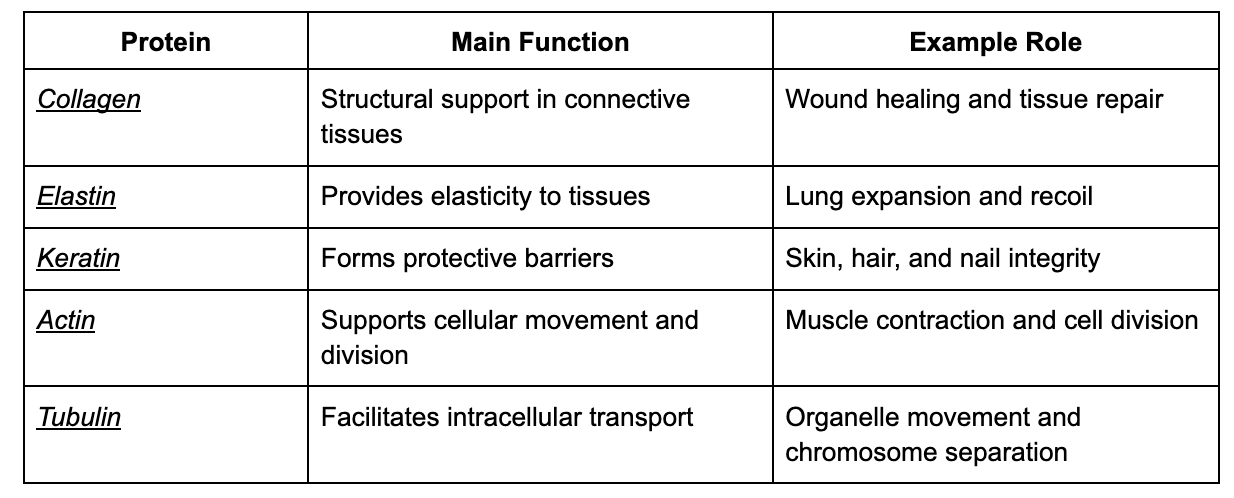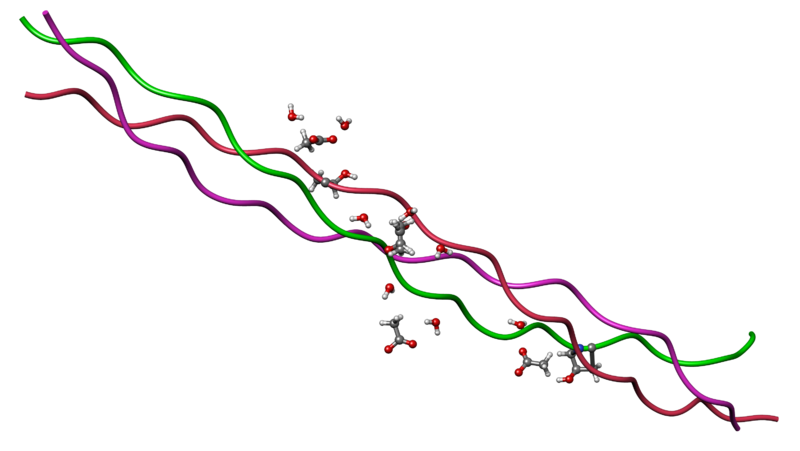The 5 Essential Roles of Proteins in Cellular Functions
Proteins are the molecular machines that keep our bodies functioning. They perform a wide range of roles, from providing structural support to enabling cellular movement. In this article, we’ll explore five critical proteins—collagen, elastin, keratin, actin, and tubulin—and their unique functions in the body.
What Are Proteins?
Proteins are made up of amino acids and play a crucial role in almost every biological process. Unlike carbohydrates and fats, proteins are not a source of energy but instead act as structural components, enzymes, transporters, and signaling molecules. Each protein is uniquely suited for its specific role, helping maintain the body’s structure, enable movement, and support cellular functions.
1. Collagen: The Body’s Structural Framework
MarinaVladivostok, CC0, via Wikimedia Commons
Collagen is the most abundant protein in the human body, making up about 30% of the total protein content. It serves as a key structural component in connective tissues, including bones, skin, tendons, and cartilage. Collagen’s triple-helix structure provides tensile strength, allowing tissues to withstand stretching and stress.
Role in Wound Healing: Collagen is essential for tissue repair. During wound healing, collagen fibers are deposited at the injury site to support tissue repair, acting as a scaffold for new cell growth.
Clinical Relevance: Defects in collagen, such as those seen in Ehlers-Danlos syndrome, can lead to fragile tissues and impaired wound healing.
2. Elastin: The Protein of Flexibility
Elastin provides elasticity to tissues that undergo regular stretching, such as the lungs, skin, and blood vessels. It acts like a natural rubber band, allowing these tissues to expand and recoil back to their original shape. Elastin’s coiled structure enables this flexibility, supporting the function of organs that stretch repeatedly.
Example in Lung Function: In conditions like emphysema, elastin in the lungs is degraded, leading to loss of elasticity and difficulty breathing, as the alveoli struggle to expand and contract.
3. Keratin: The Body’s Protective Shield
Keratin is a structural protein found in the skin, hair, and nails. It forms strong fibers that provide resistance against physical damage, pathogens, and water loss. Keratin’s alpha-helical structure assembles into tough, durable fibers, creating a protective barrier for the body.
Clinical Relevance: In disorders like epidermolysis bullosa, mutations in keratin make the skin fragile, causing it to tear easily. This highlights keratin’s crucial role in maintaining tissue integrity.
4. Actin: The Engine of Cellular Movement
Actin forms microfilaments within cells, playing a vital role in muscle contraction, cell movement, and cell division. In muscles, actin interacts with myosin to produce the force needed for contraction, a process regulated by calcium ions and ATP.
Role in Cell Division: During cell division, actin forms a contractile ring that helps separate two daughter cells, supporting processes like wound healing and immune responses.
5. Tubulin: The Cellular Highway
Tubulin forms microtubules, which act as transport highways within cells. Microtubules support the transport of organelles, vesicles, and other cargo. Tubulin also plays a critical role in cell division by forming the mitotic spindle, which separates chromosomes during mitosis.
Clinical Relevance in Neurodegeneration: In diseases like Alzheimer’s, disruptions in tubulin dynamics can impair intracellular transport, leading to cell dysfunction.
Proteins in Health and Disease
Understanding these proteins can also provide insights into various diseases. For instance, mutations or defects in collagen and keratin lead to connective tissue and skin disorders, while disruptions in tubulin dynamics are associated with neurodegenerative conditions. Additionally, drugs like paclitaxel target tubulin to stabilize microtubules and prevent cancer cells from dividing, showcasing the clinical applications of understanding protein function.
Dive Deeper with King of the Curve
Proteins are a foundational topic in biology and medicine. If you're interested in learning more about these and other essential biological concepts, explore the King of the Curve app. With resources like practice questions, interactive quizzes, and in-depth explanations, King of the Curve is here to help you master complex concepts in a fun and engaging way.
-
Our platform is designed for students preparing for the MCAT, DAT, PA-CAT, NCLEX, and Step 1 exams, particularly those who are a few months out from their exam date, and looking to significantly boost their scores.
If you’d benefit from a proactive study routine that helps you make the most of your time and avoid the woes of cramming, King of the Curve is for you.
Whether you’re starting with a strong academic background or prefer extra support, KOTC adapts to your abilities and delivers personalized content to help all students achieve their goals.
-
King of the Curve combines serious, exam-level content with a gamified and engaging platform—striking a balance that no other tool has achieved.
Our content matches the difficulty of real exams, ensuring you’re thoroughly prepared. What sets us apart is that students enjoy using KOTC even when they’re not under the immediate pressure of a looming exam. This makes us a powerful long-term tool for memory retention, helping students stay proactive in their preparation and excel in their coursework well before test day.
-
Improved Score: The average user increases their score 4 percentile points per month on current exam offerings.
Saved Time: You'll no longer need to re-learn material because our platform is designed around your long-term memory.
Less Stress: Your goal results are attained effortlessly and enjoyably.
Social Experiences: Our platform is designed to foster social experiences. Through competition and challenges, KOTC has become a mania on college-campuses.
Good Study Habits: Our platforms serves as a reset, so you can go about your day with intention.



